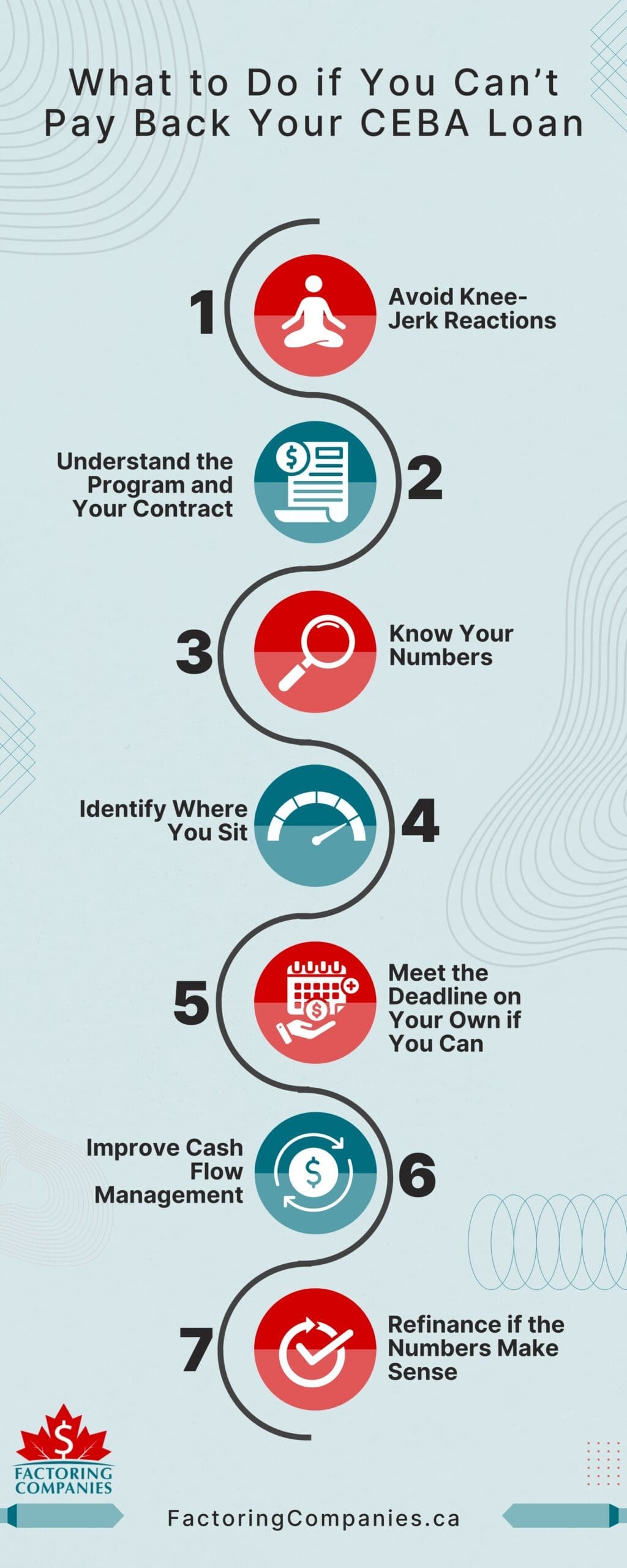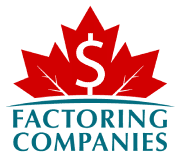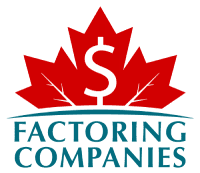
Worried you can’t pay back your CEBA loan in time? You’re not alone. Nine in ten businesses accessed CEBA loans during the pandemic, and 78 percent have not made any payments toward their balances yet, according to the Canadian Federation of Independent Business (CFIB). The organization notes that two in five CEBA users were at risk of missing the original December 2023 repayment deadline, putting around a quarter million businesses at risk of closure. Although the deadline has now been bumped to January 18, 2024, CFIB says it’s “not good enough,” to protect small businesses, as it still means most will not qualify for forgiveness, CTV News reports.
The good news is that you have options even if you can’t pay back your CEBA loan yet. We’ll walk you through how CEBA loans work, discuss steps you can take right now if you’re unsure you’ll meet the deadline, and review frequently asked questions on this page.
Strategic Planning for CEBA Loan Repayment
Strategic planning for CEBA loan repayment is crucial for ensuring your business remains viable and your loan is in good standing. It starts with a thorough understanding of the CEBA program and its terms, which is vital for every business owner who has received the loan. The first step in strategic planning is to assess the total outstanding debt and set a realistic timeline for repayment.
To effectively repay your CEBA loan, consider drafting a detailed repayment plan that involves examining your business’s cash flow, costs, and potential revenue streams. This might include implementing cost-cutting measures or redirecting funds from less critical areas to prioritize loan repayment. Remember, the ability to repay becomes more challenging if you miss the initial forgiveness window, turning an interest-free loan into a term loan with interest.
Furthermore, if you’re unable to repay your CEBA loan on time, it’s important to contact the CEBA call centre or seek advice from a licensed insolvency trustee to explore options such as refinancing the loan or restructuring your business’s finances. Engaging with professionals can provide insights on maintaining the viability of your business while managing your debts effectively.
CEBA borrowers should also consider regular reviews of their business’s financial status. Keeping a pulse on your financial health helps you anticipate challenges in repaying the loan. Tools like financial forecasting models can aid in predicting future revenue and expenses, allowing for adjustments in your repayment plan as needed.
In the case of severe financial distress, where a business owner finds themselves unable to pay back their loan, options like filing a consumer proposal might be considered. This approach can mitigate the impact on personal assets, especially if the business is a sole proprietorship and the owner is personally liable for repayment.
Adopting these strategies helps manage CEBA loan repayment effectively and enhances your business’s overall financial strategy, ensuring you are better positioned to manage any future economic downturns.
How CEBA Loans Work

Canada Emergency Business Account (CEBA) loans were the Canadian government’s way to support small businesses during the pandemic. The program was widely popular, with 89 percent of companies taking advantage of the funds. Many refer to it as a “lifeline” and believe their CEBA loan is the only reason their business survived the pandemic.
Qualifying for CEBA Loans
Nearly 900,000 businesses were approved for CEBA loans, according to the official CEBA website. Businesses could qualify for up to $40,000 during the first round of funding. Afterward, the Canadian government offered CEBA expansions of up to an additional $20,000 for any business that initially qualified for the entire $40,000. Over 500,000 businesses qualified for these. More than $49 billion went to companies through CEBA loans and expansions.
CEBA Loan Terms and Repayment
CEBA loans are unique for several reasons:
- No interest is accrued before the first deadline.
- No payments are required before the first deadline.
- Part of the debt is forgiven if the remaining balance is paid in full before the first deadline.
- After the first deadline passes, the loans convert into two-year term loans with five percent interest.
The initial deadline was set for December 31, 2022, but was then extended to December 31, 2023, and has now been bumped out to January 18, 2024. That means businesses now have until mid-January of 2024 to pay off their balances to have a portion of their debts forgiven. Those who miss the deadline must start making interest-only payments at a minimum. The full balance becomes due on December 31, 2026.
CEBA Loan Forgiveness
Businesses that qualified for up to $40,000 can have up to 25 percent of their loans forgiven. Those that qualified for an extension can have up to 50 percent of the extension forgiven.
For instance, if your business qualified for a $40,000 loan and you pay $30,000 before January 18, 2024, the remaining $10,000 will be forgiven.
If you qualified for $50,000 (an initial $40,000 CEBA loan and a $10,000 expansion), you’d have to repay $35,000 before the end of the year for the remaining $15,000 to be forgiven.
What to Do if You Can’t Pay Back Your CEBA Loan

Around 40 percent of Canadian small businesses are still heavily in debt, and 47 percent are making subpar revenue, according to CFIB surveys. With these figures in mind, it’s no wonder that two in five businesses don’t think they can pay their CEBA loans back before the deadline. Moreover, half of those who say they can pay their loans believe it will still be a struggle. Let’s look at what you can do if you fall into either of those categories.
Avoid Knee-Jerk Reactions
Don’t act until you fully understand your position and all potential outcomes. You don’t have to do anything right now, but taking specific steps can minimize the total amount you pay back in the end.
Understand the Program and Your Contract
We provided basic details about how CEBA loans work above. However, each contract may be slightly different, and specific details, like your business structure, impact how non-payment will affect you. Make sure you have a copy of your contract so that you can review all the details before making any decisions.
Know Your Numbers
Most businesses received $40,000 or less. That means what’s really on the table is $10,000 in loan forgiveness and around $4,000 in interest that you’d pay if you make interest-only payments until the 2026 deadline.
Evaluate your contract to determine what you’ll gain by paying before the December deadline and what you can expect if you take the additional two years to pay off the balance.
Pull your financial statements during this step too. Take a hard look at your cash flow and what you can anticipate in the coming six to 30 months. Make a note of what you can realistically put toward your debt each month and any obstacles that might prevent you from meeting your goal.
Identify Where You Sit
Once you evaluate your numbers, you’re likely to fit into one of three categories:
- The business can pay off its CEBA loan before January 18, 2024, without issue.
- You’re close to being able to pay off 75 percent of your CEBA loan before the deadline, or you believe you can make it work with a few modifications.
- There’s no way you can pay off 75 percent of your CEBA loan before January 18, 2024.
If you fall into the first category, you may not need any special modifications. However, you may want to behave as if you fall into the second category to ensure your loan is paid off even if you face an unexpected obstacle.
Meet the Deadline on Your Own if You Can
The most significant benefit to paying your CEBA loan before the deadline is qualifying for partial loan forgiveness, which can reduce the total amount owed by up to $20,000 for businesses that received the maximum CEBA loan and expansion.
Improve Cash Flow Management
Cash flow management is key if you’re close to paying off your CEBA loan by the deadline or are trying to minimize interest. At a basic level, this involves stopping or slowing cash outflows and increasing or accelerating cash inflows.
Cut Costs
You’re probably already running a tight ship, but look through your finances to see if you can reduce costs anywhere. Pay special attention to areas like vendor costs, payroll, and rent, which can add up quickly.
Evaluate Your Payables Schedule
Many small businesses only make payments once or twice per month. That ensures bills get paid on time, but it may also mean that money’s leaving your account faster than it needs to. See if there are ways to keep more money in your business where it can be applied to growth initiatives or toward accepting the next order.
Increase Receivables
Explore opportunities for additional revenue streams or ways to increase sales. Depending on your business model, even improving in areas such as customer retention or upselling to existing clients may help bridge the gap. You may also be able to increase new business through effective marketing or expanding into new markets.
Accelerate Receivables
Are any of your clients on payment plans, or do they get longer terms to pay their invoices? If so, see how you can encourage them to pay quicker. For instance, if you usually give clients 30 or more days to pay, consider reducing the timeframe or offering a slight discount for early payment.
If you’re in an industry where accelerating payments is abnormal or doing so will harm client relationships, consider invoice factoring. With this approach, you sell your unpaid invoices to a factoring company at a slight discount. Clients stay happy because you can continue to provide them with flexible terms. Your business benefits because it receives upfront cash that can be put toward CEBA loan payments, growth initiatives, or whatever makes the most sense for your company – all without taking on more debt.
It’s also worth noting that you control which invoices you factor. That means you can start accelerating payment immediately on all your invoices or just factor some. You can also get set up with a factoring company now and not factor a single invoice until the end of the year. That way, you have access to a quick cash flow injection if you need it to meet the deadline for partial loan forgiveness.
Refinance if the Numbers Make Sense
Many businesses are rushing to refinance because submitting an application with the financial institution that provided their CEBA loan by January 18, 2024, extends the partial loan forgiveness window to March 28, 2024, but this isn’t always the wisest decision. Origination fees alone on a typical loan can be as high as five percent, meaning you’re automatically paying $2,000 in fees on a $40,000 loan. This doesn’t even take into account that your interest rate will likely be higher, too.
Other forms of refinancing can be even worse. For instance, merchant cash advances can have APRs of over 200 percent. That works out to $80,000 in fees in some cases.
Factoring may be a more ideal solution here as well. Although it’s not a loan, it can help you pay your CEBA loan off quicker. In this sense, it may help you meet the loan forgiveness deadline and reduce interest payments since you only pay for the invoices you factor and don’t create more debt to pay off.
CEBA Loans FAQ

By now, you should understand how CEBA loans work and the steps you can take if you can’t pay off your CEBA loan. Let’s fill in any potential knowledge gaps by answering some questions small-business owners are asking about CEBA loans.
Are You Personally Liable for a CEBA Loan?
You may be personally liable for your CEBA loan. It depends on your business structure and your contract. If your business is set up as a sole proprietorship as opposed to a corporation, for example, the business owner’s assets may be at risk if the loan goes unpaid. Equally, if you signed a personal guarantee, you’re also personally liable for the debt. Check your contract and speak to a lawyer if you have concerns.
Can You Repay a CEBA Loan Early?
Yes, you can repay CEBA loans early. Doing so can save businesses tens of thousands of dollars through the loan forgiveness program and interest.
Can You Still Qualify for a CEBA Loan?
No, the application period for CEBA loans closed on June 30, 2021, according to the official CEBA website.
Can a CEBA Loan Be Transferred to Another Bank?
The word “transferred” is often used, but it’s usually refinancing. You’re starting from scratch and paying fees to create a new loan to pay off the old one.
Can a CEBA Loan Be Forgiven?
A portion of your CEBA loan can be forgiven if you stay in good standing with the loan and pay off all but the forgivable portion before January 18, 2024. If your business received $40,000 or less, you must pay 75 percent of the CEBA loan before the end of the year.
Will the CEBA Loan Forgiveness Deadline Be Extended?
The CEBA loan forgiveness deadline has already been extended twice. It’s unlikely to be extended again.
Alternative Financing Options if CEBA Repayment is Not Feasible
For some businesses, despite best efforts, repaying their CEBA loan may not be feasible due to ongoing financial difficulties. If you find yourself unable to repay your CEBA, it’s crucial to know the alternatives that can prevent the situation from escalating to more severe consequences like business closure or bankruptcy.
One potential avenue is to refinance your CEBA loan. This could involve taking a new loan under different conditions to clear the CEBA loan, potentially offering lower interest rates or more favorable repayment terms. It’s important to calculate the costs associated with refinancing to ensure it actually provides a financial benefit over the existing obligations.
Another option might be to negotiate with the lender for modified repayment terms. Some lenders might offer extended deadlines or allow for interest-only payments for a period. Communication with your lender is key; they may have options assigned specifically to the CEBA program to help businesses in distress.
For those with more severe financial challenges, contacting a licensed insolvency trustee to discuss filing for a consumer proposal or even bankruptcy could be a step to consider. These options can offer a way to legally settle debts when no feasible repayment alternatives exist. While drastic, they provide a structured way to handle business debts and can offer a fresh start in some cases.
Additionally, exploring other government relief programs might provide the necessary support. Programs sometimes offer grants or loans with more lenient terms which could be used to manage or consolidate existing debts, including a CEBA loan.
Lastly, consider non-traditional funding sources like crowd-funding or investor capital. These might not only help in loan repayment but could inject new funds into your business, helping bridge the gap during tough times and potentially paving the way for renewed growth.
Exploring these options provides a safety net for businesses struggling with CEBA repayment, ensuring they have strategies to maintain operations and safeguard the business’s future.
Pay Back Your CEBA Loan Faster with Invoice Factoring
It’s best to pay your CEBA loan back before the January 18, 2024, deadline to take advantage of the loan forgiveness program, but even if you can’t, paying it off before the final deadline at the end of 2026 will still reduce interest. If you need cash to accelerate business growth, so it’s easier to pay off your loan or just want to accelerate cash flow to ensure you meet a deadline, invoice factoring can help. Request a complimentary rate quote to learn more or get started.
Please note that this page only provides general information and should not be considered legal or financial advice. Always work with a professional who knows your business if you have questions.
This article was updated on September 15, 2023, to reflect the new payment deadlines.

About Factoring Companies Canada
Related Articles
Get an instant factoring estimate
Factoring results estimation is based on the total dollar value of your invoices.
The actual rates may differ.
CLAIM YOUR FREE FACTORING QUOTE TODAY!
PREFER TO TALK?
You can reach us at
1-866-477-1778
Get an instant factoring estimate
Factoring results estimation is based on the total dollar value of your invoices.
The actual rates may differ.
CLAIM YOUR FREE FACTORING QUOTE TODAY!
PREFER TO TALK? You can reach us at 1-866-477-1778









